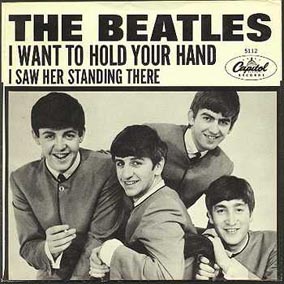| "I Saw Her Standing There" (Lennon, McCartney) [2:52] |
 |
|
| McCartney (commenting on September 1962): " . . . I'd started it and I had the first verse, which therefore gave me the tune, the tempo and the key. It gave you the subject matter, a lot of the information, and then you had to fill in. I had, "She was just seventeen, she'd never been a beauty queen." So we went, "Ugh, this is one of these." And by then we'd written a couple in the little book and we'd started to realise that we had to stop at these bad lines or we were only going to write bad songs. So we stopped there and both of us cringed at that and said, "No, no, no. Beauty queen is out! There's got to be another rhyme for seventeen": so we went through the alphabet: between, clean, lean, mean; "She wasn't mean; you know what I mean; great! Put that in." And then the significance of it built as we sang it, "She's just seventeen, you know what I mean?" and people picked up on the implied significance later. It was a good way out of that problem. So it was co-written, my idea, and we finished it that day. (Miles 1997: 93-94). |
| McCartney (on the bass line): I played exactly the same notes as he did [Chuck Berry's "I'm Talking about You" (1961)] and it fitted our number perfectly. Even now, when tell people about it, I find few of them believe me. Therefore I maintain that a bass riff doesn't have to be original. (Miles 1997: 94) |
| Section | Time | Meas. | Description | Text | |
| A' | intro | 0:00 | 4 | Ensemble vamp with hand claps doubling snare drum. | — |
| A1 | verse | 0:09 | 8 | Vocal solo over vamp pattern | a |
| A2 | refrain | 0:20 | 8 | Vocal duet. | b1 |
| A1 | verse | 0:32 | 8 | As in verse above | c |
| A2 | refrain | 0:44 | 8 | As in refrain above | b2 |
| B | chorus | 0:56 | 10 | Vocal duet (extension of refrain?) | d |
| A1 | verse | 1:11 | 8 | As in verses above. | e |
| A2 | refrain | 1:23 | 8 | As in refrains above. | b3 |
| A1 | verse | 1:35 | 8 | Guitar solo. | — |
| A2 | refrain | 1:47 | 8 | — | — |
| B | chorus | 1:59 | 10 | As in chorus above. | d |
| A1 | verse | 2:14 | 8 | As in verses above | e |
| A2 | refrain | 2:26 | 8 | As in refrains above. | b3 |
| A" | coda | 2:37 | 8 | Repeat hook twice (thrice including refrain). | |
| Text | |
| Well
she was just seventeen, you know what I mean, and the way she looked was way beyond compare. |
a |
| So how could I dance with another, oh When I saw her standing there. | b1 |
| She wouldn't dance with another, oh When I saw her standing there. | b2 |
| Now I'll never dance with another, oh Since I saw her standing there. | b3 |
| Well she looked at me and I, I could see, that before too long, I'd fall in love with her. | c |
| Well my heart went boom when I crossed that room, and I held her hand in mine . . . . | d |
| Well
we danced through the night, and we held each other tight, and before too long, I fell in love with her. |
e |
| Go to | ||
| Lennon & McCartney | Outline | Bit of Work |
| 03-Sep-2009 |